The trip we just took, for only a couple of days, was down to Beaufort, North Carolina, a coastal town nestled among a cluster of barrier islands. It’s typical for coastal, tourist-oriented towns: quaint, lots of shops, fancier restaurants, and various activities aimed at tourists. Among the latter were ferry trips out to some of the barrier islands, and among those destinations is Shackleford Banks: not quite 13 kilometers long and 1.5 at its widest, undeveloped and part of the National Park Service protected areas, largely because of the horses. The island is home to a colony of wild horses, a breed known as Banker horses (Equus ferus caballus) that have been there for many decades, rumored to have come ashore from Spanish shipwrecks – if true, this would make them present for at least two centuries, but documentation about the island is scarce so the origin of the colony is questionable. Still, they’re entirely feral, one of the few places in the US where you can find wild horses.
We went into this trip with the idea that actually spotting them might be tricky, especially with a long island for them to hide within, and I was mentally prepared to not see any, or only at a great distance, and it is with some retrospect amusement that I recall evaluating the occasional mound of horse feces we came across for apparent age, trying to determine if it had been deposited recently. Within the first half hour, we spotted our first horse in the distance, as indicated in yesterday’s post. And then another.

This is with the long lens, and I wasn’t judging the distance at the time but estimate it now at a little over a hundred meters. We had no idea how wary they’d be, and approached carefully.
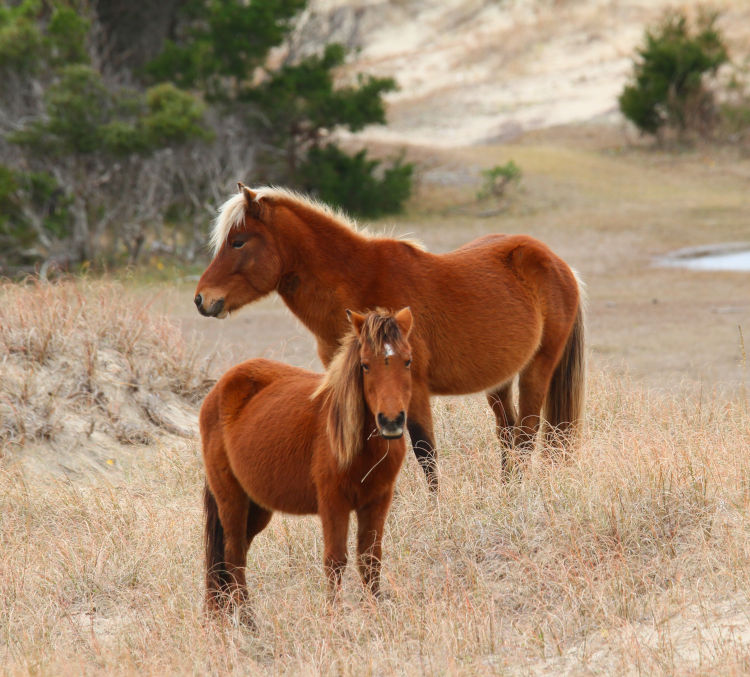
Visitors are warned to avoid close approaches or any contact, since the horses might consider it a threat, and of course no feeding is allowed. But there are numerous ferry trips taking visitors out there every day, so the horses are also acclimated to the presence of people. Thus, they kept a wary eye on us but otherwise went about their own business, which if you know horses at all means simply grazing.

I missed an opportunity here, when the horse in the back appeared over the ridge striding purposefully and dramatically, looking more regal than this, and I couldn’t ever time it so all three were looking at us simultaneously, but so it goes. We only did the one trip that lasted for just a couple of hours, meaning opportunities were a little limited. Not to mention that the sky remained resolutely overcast, though not darkly – occasionally the glowing ball of the sun could be discerned through the cover. The temperature was right on the border of uncomfortable; being on the ocean, the wind was near-constant, though broken a little by the terrain, and we were experiencing slightly warmer than typical winter temperatures for this region, a little better than 12°c.
The terrain deserves a mention since it’s a barrier island and thus mostly sand, within which only certain plants can grow at all. It’s hilly, though – not hugely, but more than I would have expected, and so it was possible to suddenly discover a horse only a handful of meters away as you crested a hill or rounded a bend. Between the wind, Atlantic storms, and constant churning of hooves, it’s loosely packed, and so tramping around up and down hills took more effort than most hikes – not terribly strenuous, but certainly stretching out the leg muscles. And the food available for the horses, at least in the immediate region, was what you see here: long coarse beach grasses well past growing season. And juniper bushes, which to the best of my knowledge horses can’t eat. How they managed through the winter, I can’t say, though I imagine the park service might provide supplemental food, and we were told that birth control was administered to limit the number of breeding females.
At one point we heard some soft whinnying in the middle distance, and as we were starting along one of the trails that meandered across the island in that direction, another horse appeared bearing towards us, so we respectfully gave it room. It passed with barely a glance, then paused not too far from the others on the hill and gave out a couple more whinnies – unfortunately, autofocus was being balky at that moment.
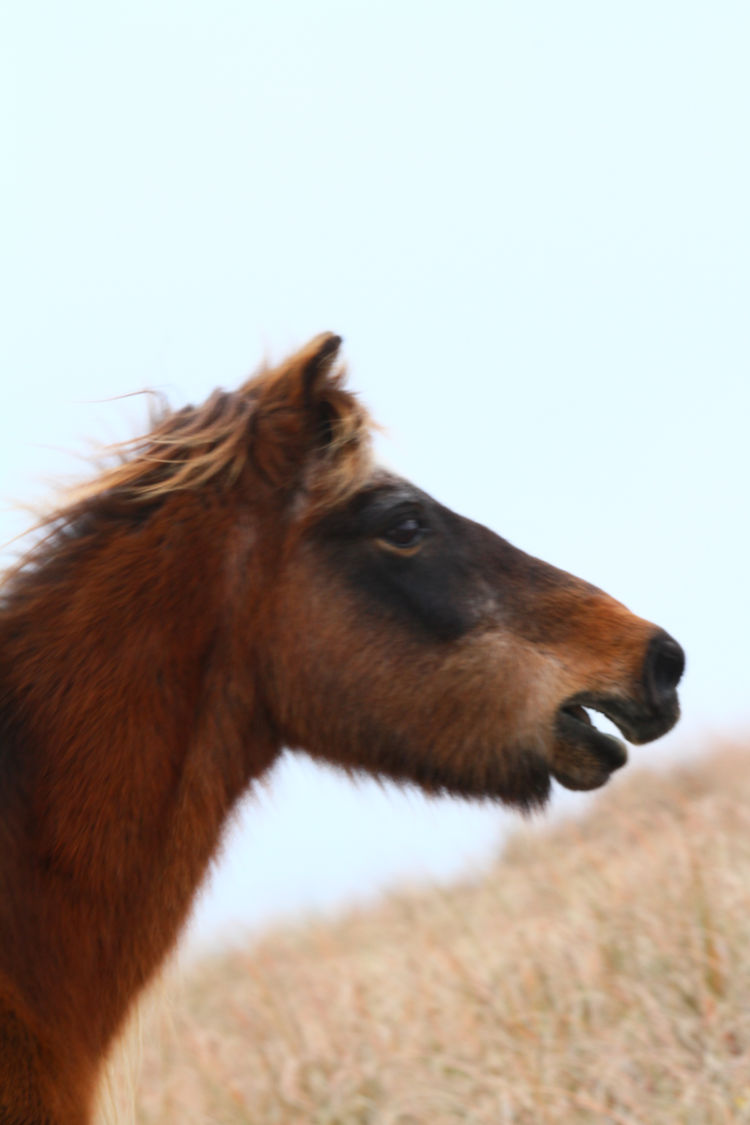
To appearances, this one wanted to join the others on the hill, though my experience with horse behavior is not exhaustive (or even adequate.) The larger horse up highest immediately took notice of this ‘request’ and stood staring at this new arrival.
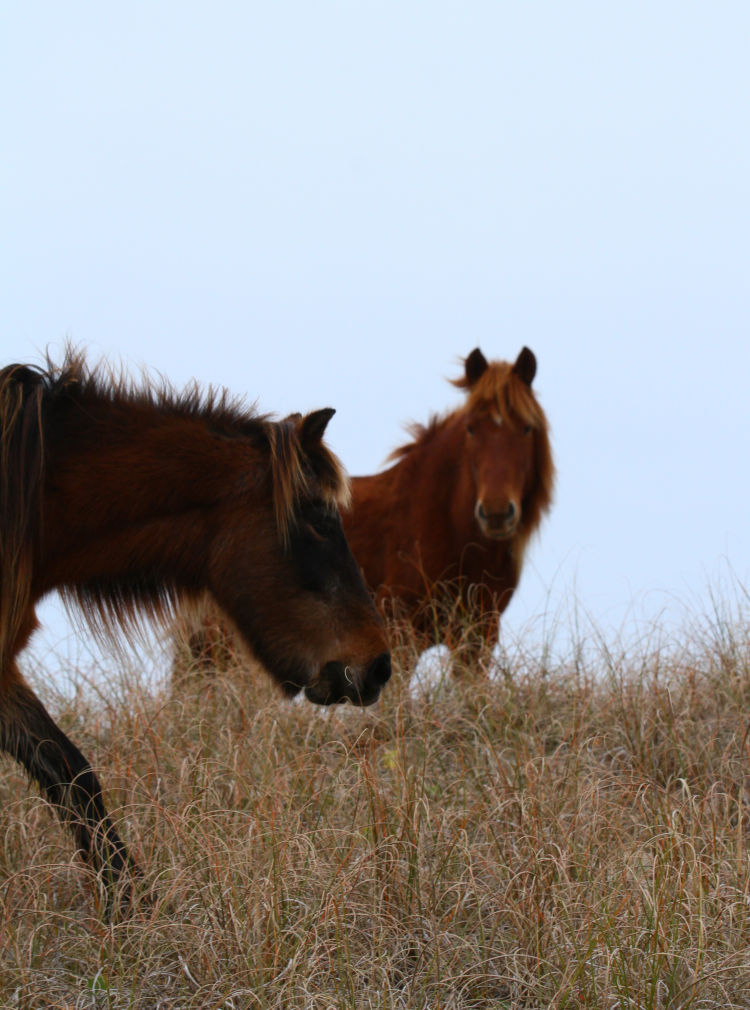
The attention was unwavering, and shortly thereafter, it became clear that this really was the stinkeye, because the larger one in the back chased the smaller, foreground one off – not energetically, but sufficiently; the little guy was not welcome here.
Due to shooting against the sky so often, I was constantly trying to remember to adjust exposure compensation depending on where I was aiming, which could change at any time, and didn’t always remember; it probably would have been much worse with a sunny day. Briefly, the exposure meter in the camera judges the light in the frame but doesn’t know what it sees, and that the sky, for instance, is supposed to be that bright, so when shooting against the sky, compensation needs to be set to keep it bright. But with the dark juniper bushes as a background, it’s unnecessary. And of course, when something interesting is happening, you want to simply aim and shoot and not mess about with settings. My advice: one of the control dials on your camera should always remain set to adjust exposure without additional buttons or menus. And then, always keep it in mind.

All of the horses were the same chestnut color, though with variations in mane and face, all had thicker winter coats, and all had the shorter, stockier bodies more reminiscent of ponies, but I believe this is typical; the long-legged, lean and sleek horses that we’re used to have been bred for riding and racing, while this is not an ideal body for surviving in the wild.
It’s funny – I wouldn’t spend more than a few minutes photographing any domestic horse, and even then I’d be watching for something either compelling or portrait-oriented, so all of the frames that I took here were only due to the knowledge that these were “wild,” and that title is up for grabs; were they truly feral, or more acclimated than not? Do non-acclimated horses even exist anywhere anymore?
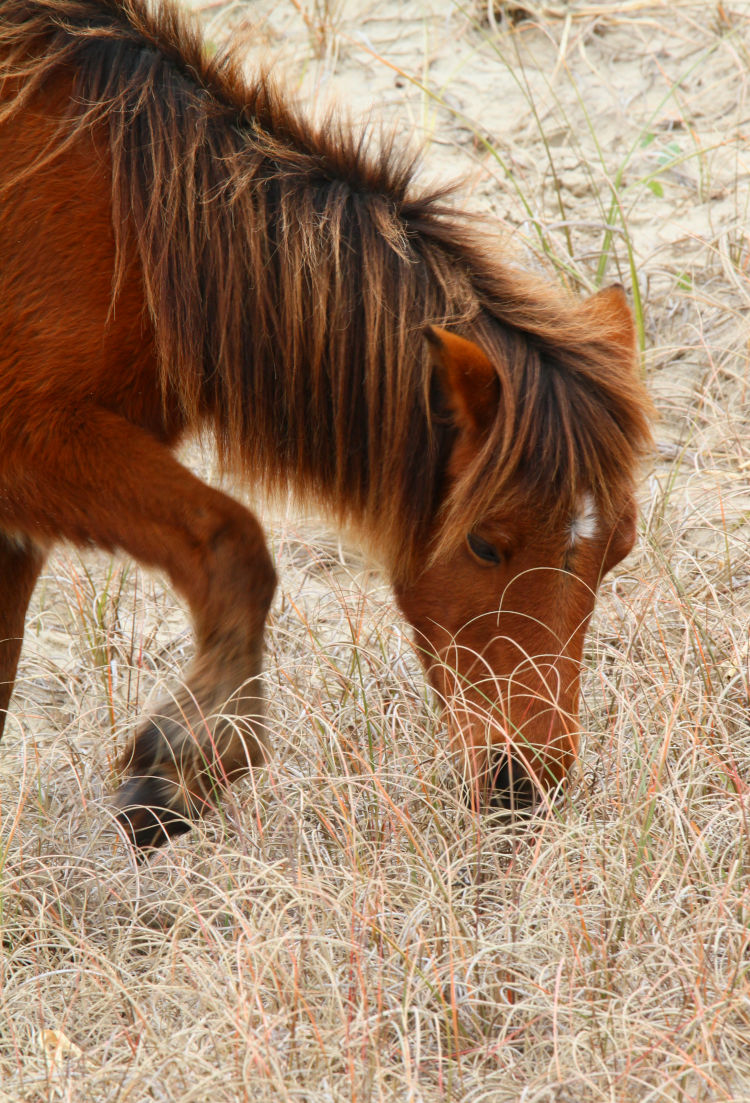
This one was pawing at the turf, if I can call it that, trying to stir up something within, but I couldn’t determine what might be there to dig up. I also never discovered where they got their fresh water from; channels on the island indicated that the two waterpools we found were flooded by saltwater periodically, so I’m supposing there were catch basins elsewhere for rain that the horses could drink from. I find it unlikely that there might be a spring or something, given the island’s position and composition.
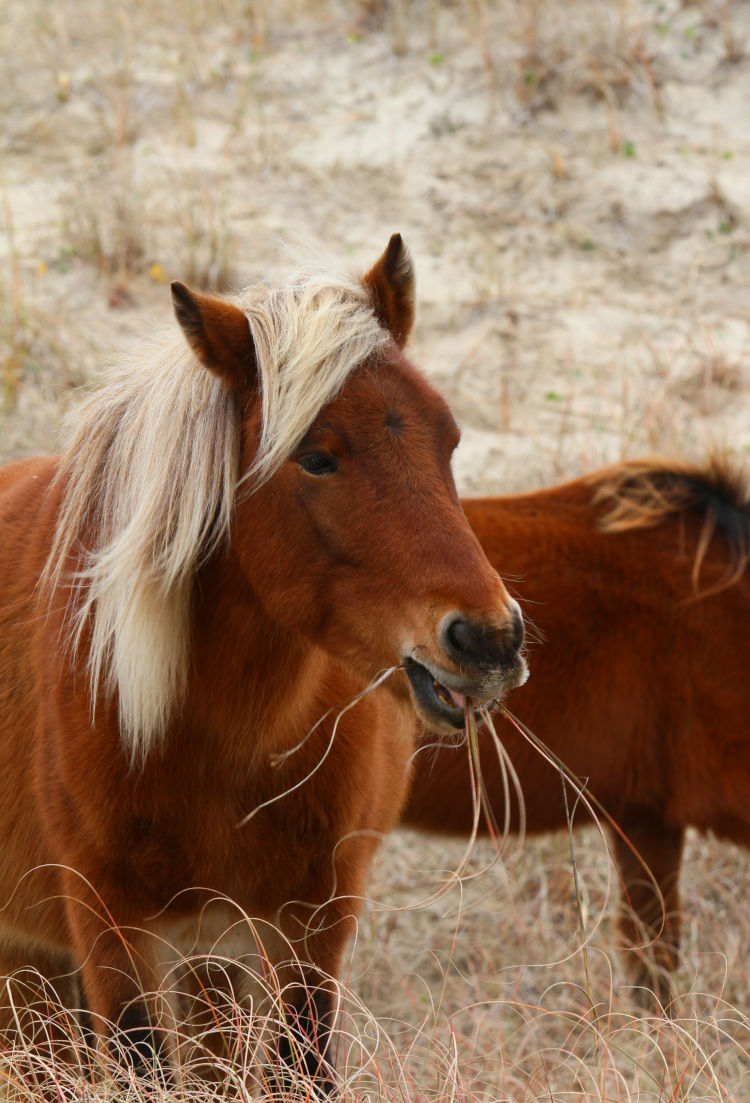
By the way, all of these were taken with the 150-600mm lens – to begin with, because we were at a notable distance, but also to avoid close approaches. However, several times I had to shorten down quite a bit because we were pretty close; this one was at 273mm, while the horse getting the stinkeye above was at a mere 150mm.
I also played with more evidence of their locale.
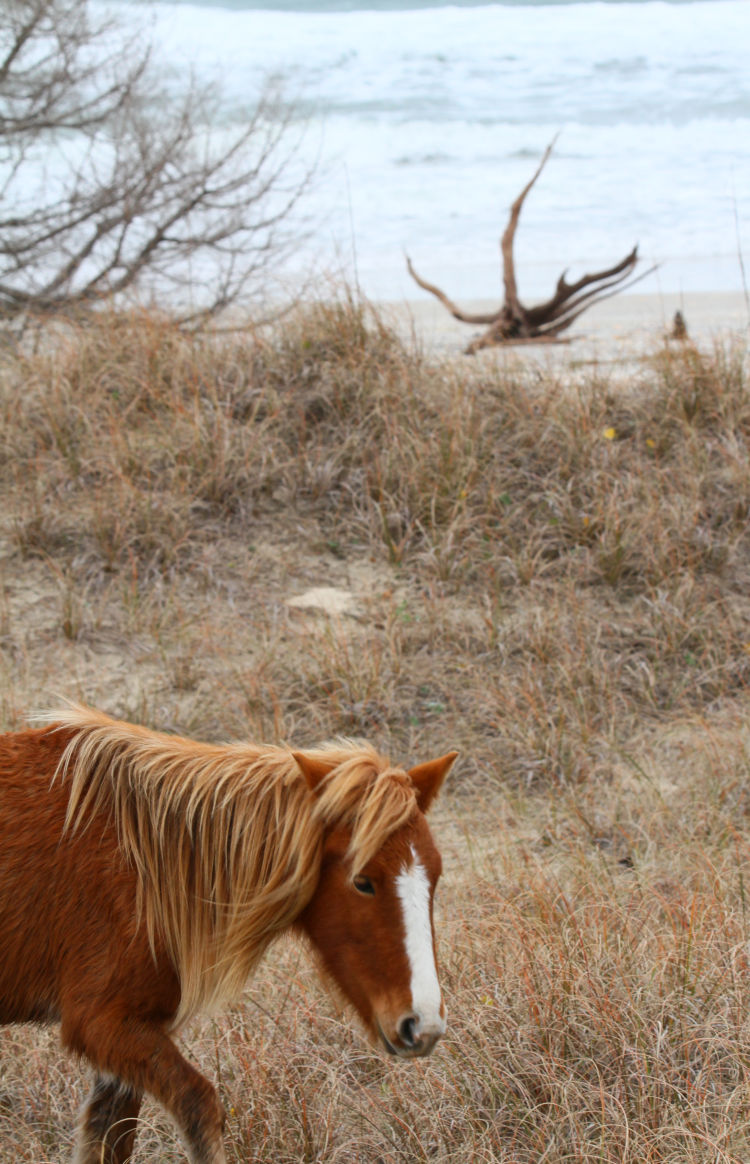
None of them came near the beach while we were watching, though some hoofprints along the foliage line could be found. So this had to be arranged through a saddle in the sandhills – not framed as well as I would have liked, but it suffices for now. We’ll return some day, perhaps before the end of next year.
I’ll close with another fartsy shot, shamelessly tweaked a little for better color and contrast. Simple, yet expressive of the conditions, and yes, the hills really were that steep, though I doubt the tallest topped 10 meters. I’m curious what it looks like in the spring and summer, and also whether these were typical viewing conditions or if we had a lucky day – we saw at least fifteen separate horses, near as I can judge, but between their wandering and ours, there may have been more repeats in there than I thought.
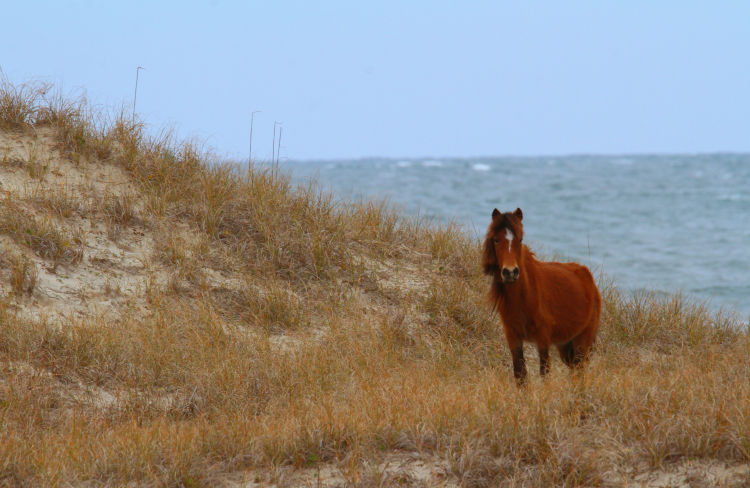
More photos, of other stuff, will be along shortly.




















































